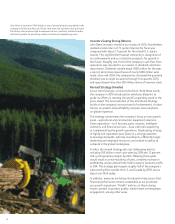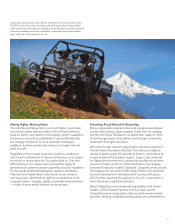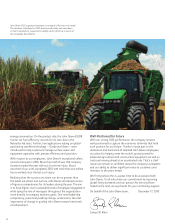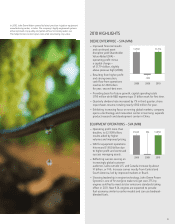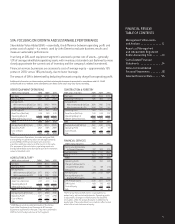John Deere 2010 Annual Report Download - page 16
Download and view the complete annual report
Please find page 16 of the 2010 John Deere annual report below. You can navigate through the pages in the report by either clicking on the pages listed below, or by using the keyword search tool below to find specific information within the annual report.
16
more than offset by price realization of 5 percent. Net sales in
the U.S. and Canada decreased 14 percent in 2009. Net sales
outside the U.S. and Canada decreased by 28 percent in 2009,
which included an unfavorable effect of 8 percent for currency
translation.
Worldwide Equipment Operations had an operating
profi t of $1,365 million in 2009, compared with $2,927 million
in 2008. The deterioration in operating profi t was primarily due
to lower shipment and production volumes, the unfavorable
effects of foreign currency exchange, a goodwill impairment
charge, higher raw material costs and voluntary employee
separation expenses, partially offset by improved price realization
and lower selling, administrative and general expenses.
The Equipment Operations’ net income, including
noncontrolling interests, was $677 million in 2009, compared
with $1,677 million in 2008. The same operating factors
mentioned above, in addition to a higher effective tax rate,
affected these results.
Trade receivables and inventories at October 31, 2009
were $5,014 million, compared with $6,276 million in 2008,
or 24 percent of net sales in both years.
Net income of the company’s Financial Services
operations in 2009 decreased to $203 million, compared with
$337 million in 2008. The decrease was primarily a result
of a higher provision for credit losses, lower commissions from
crop insurance, narrower fi nancing spreads and higher losses
from construction equipment operating lease residual values,
partially offset by a lower effective tax rate primarily from wind
energy tax credits and lower selling, administrative and general
expenses. Additional information is presented in the following
discussion of the “Worldwide Credit Operations.”
The cost of sales to net sales ratio for 2009 was 78.3
percent, compared with 75.9 percent in 2008. The increase
was primarily due to lower shipment and production volumes,
unfavorable effects of foreign exchange, a goodwill impairment
charge, higher raw material costs and voluntary employee
separation expenses.
Finance and interest income declined in 2009 due to lower
fi nancing rates and a smaller average portfolio. Other income
decreased primarily as a result of lower commissions from crop
insurance and lower earnings from marketable securities.
Research and development expenses increased primarily as a
result of increased spending in support of new products
including designing and producing products with engines to meet
more stringent emissions regulations. Selling, administrative and
general expenses decreased primarily due to lower compensation
expenses and the effect of currency translation. Interest expense
decreased due to lower average borrowing rates, partially offset
by higher average borrowings. The equity in income of
unconsolidated affi liates decreased as a result of lower income
from construction equipment manufacturing affi liates impacted
by the low levels of construction activity.
The company has several defi ned benefi t pension plans
and defi ned benefi t health care and life insurance plans.
The company’s postretirement benefi t costs for these plans in
2009 were $312 million, compared with $277 million in 2008.
The long-term expected return on plan assets, which is
refl ected in these costs, was an expected gain of 8.2 percent in
2009 and 2008, or $857 million in 2009 and $920 million in
2008. The actual return was a gain of $1,142 million in 2009 and
a loss of $2,158 million in 2008. Total company contributions to
the plans were $358 million in 2009 and $431 million in 2008,
which include direct benefi t payments for unfunded plans.
These contributions also included voluntary contributions to
total plan assets of approximately $150 million in 2009 and
$297 million in 2008.
BUSINESS SEGMENT AND GEOGRAPHIC AREA RESULTS
Worldwide Agriculture and Turf Operations
The agriculture and turf segment had an operating profi t of
$1,448 million in 2009, compared with $2,461 million in 2008.
Net sales decreased 14 percent in 2009 due to lower shipment
volumes and the unfavorable effects of currency translation,
partially offset by improved price realization. The decrease
in operating profi t was primarily due to lower shipment and
production volumes, unfavorable effects of foreign currency
exchange, a goodwill impairment charge, higher raw material
costs and voluntary employee separation expenses, partially offset
by improved price realization and lower selling, administrative
and general expenses.
Worldwide Construction and Forestry Operations
The construction and forestry segment had an operating loss
of $83 million in 2009, compared with an operating profi t of
$466 million in 2008. Net sales decreased 45 percent in 2009
refl ecting the pressure from market conditions. The operating
profi t was lower primarily due to lower shipment and production
volumes and lower equity in income from unconsolidated
affi liates, partially offset by improved price realization and lower
selling, administrative and general expenses.
Worldwide Credit Operations
The operating profi t of the credit operations was $223 million
in 2009, compared with $478 million in 2008. The decrease in
operating profi t was primarily due to a higher provision for
credit losses, lower commissions from crop insurance, narrower
fi nancing spreads, a higher pretax loss from wind energy
projects and higher losses from construction equipment
operating lease residual values, partially offset by lower selling,
administrative and general expenses. Total revenues of the
credit operations, including intercompany revenues, decreased
11 percent in 2009, primarily refl ecting the lower fi nancing
rates and a smaller portfolio. The average balance of receivables
and leases fi nanced was 1 percent lower in 2009, compared
with 2008. Interest expense decreased 8 percent in 2009 as a
result of lower average borrowing rates, partially offset by
higher average borrowings. The credit operations’ ratio of
earnings to fi xed charges was 1.24 to 1 in 2009, compared with
1.45 to 1 in 2008.


